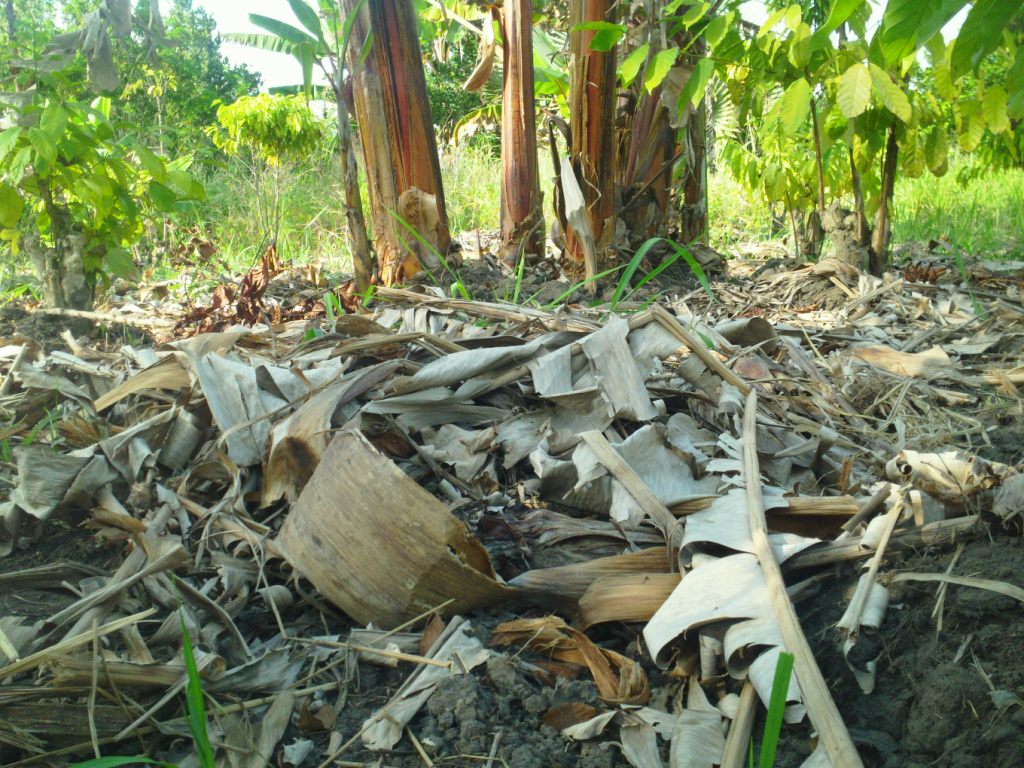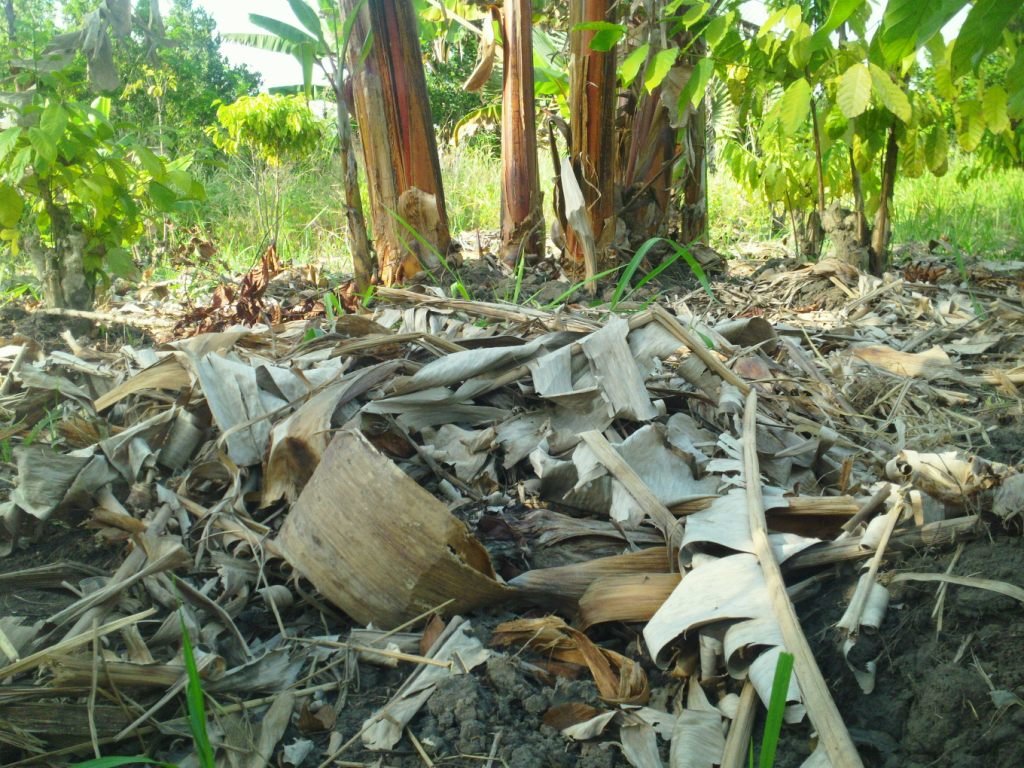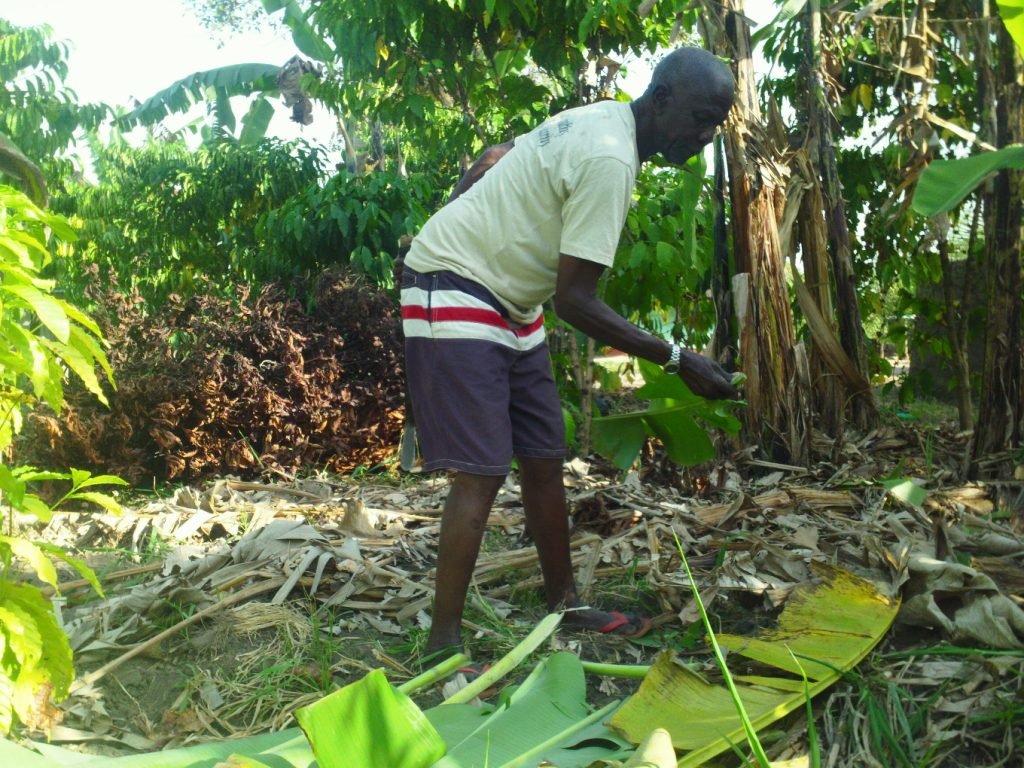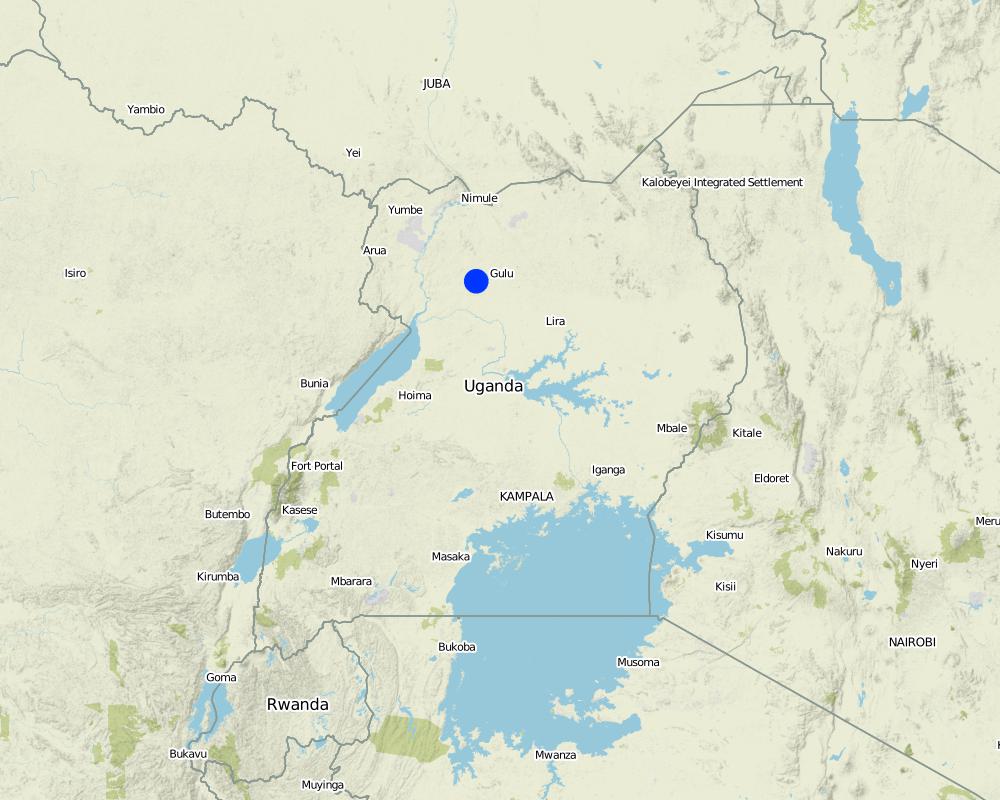Mulching using banana leaves [乌干达]
- 创建:
- 更新:
- 编制者: Kamugisha Rick Nelson
- 编辑者: JOY TUKAHIRWA, Richard Otto Kawawa, Sunday Balla Amale, Bernard Fungo
- 审查者: Drake Mubiru, Nicole Harari, Renate Fleiner, Stephanie Jaquet, Donia Mühlematter
Labolo Ma Kipo Mwanyi
technologies_2757 - 乌干达
查看章节
全部展开 全部收起1. 一般信息
1.2 参与该技术评估和文件编制的资源人员和机构的联系方式
关键资源人
土地使用者:
Ongai Andrew
Farmer
Bwobo Village, Bwobo Parish, Alero sub-county, Nwoya District.
乌干达
有助于对技术进行记录/评估的项目名称(如相关)
Scaling-up SLM practices by smallholder farmers (IFAD)有助于对技术进行记录/评估的机构名称(如相关)
CDE Centre for Development and Environment (CDE Centre for Development and Environment) - 瑞士1.3 关于使用通过WOCAT记录的数据的条件
(现场)数据是什么时候汇编的?:
24/04/2017
编制者和关键资源人员接受有关使用通过WOCAT记录数据的条件。:
是
1.4 所述技术的可持续性声明
这里所描述的技术在土地退化方面是否存在问题,导致无法被认为是一种可持续的土地管理技术?:
否
注释:
The farmer confessed that when he uses dry banana leaves, the leaves rot and provides manure which is utilized by bananas retaining the moisture content in the soil.
2. SLM技术的说明
2.1 技术简介
技术定义:
Dry banana leaves are spread in the soil for growing banana plantation for improving soil fertility and moisture content retention.
2.2 技术的详细说明
说明:
Locally obtained dry banana leaves is a low cost mulching material used by farmers in Northern Uganda to mulch soil in order to grow banana with the aim of improving soil fertility and soil moisture content retention.
The land user identifies a banana plantation usually 0.5 to 2 acres planted with sweet banana, Bogoya, Fear 17 varieties and spread the banana leaves across the banana plantation usually below 40-60 cm to the mother plant using 2-4 people per day, hoes and pangas.
Mulching is preferred because it uses locally available banana leaves within the plantation. It does not require high maintenance costs to pay for labor, digging and transport. Costs would be incurred transporting the mulching material. In addition to conserving moisture in the soils, it reduces water runoff to avoid erosion and improves the soil as the mulch material rots.
However, it is important for the land user to be aware that mulching using banana leaves serve as breeding place for banana weevils and if the land user places the mulch too close to the mother plant it will affect the growth of the young suckers. This therefore means land users who need to use this low cost mulching material need to first work out proper procedures with the extension worker on how to mulch banana plantation before mulching.
To sustain this technology, the land users can integrate cultivating multipurpose tree species (Calliandra and Grivellea) to additionally stabilize the soils and improve soil fertility when the tree mature and leaves litter.
2.3 技术照片
2.4 技术视频
注释、简短说明:
Video on mulching using banana leaves in Nwoya District.
日期:
24/05/2017
位置:
Bwobo village, Bowbo parish, Alero Sub-county Nwoya District.
摄影师的名字:
Issa Aiga
2.5 已应用该技术的、本评估所涵盖的国家/地区/地点
国家:
乌干达
区域/州/省:
Northern Region,Uganda
有关地点的进一步说明:
Nwoya District
注释:
Map showing technology site in Northern Uganda.
Map
×2.6 实施日期
注明实施年份:
2012
如果不知道确切的年份,请说明大概的日期:
- 不到10年前(最近)
2.7 技术介绍
详细说明该技术是如何引入的:
- 通过项目/外部干预
注释(项目类型等):
Supported by Nothern Uganda Social Action Fund (NUSAF) with training on how to mulch using banana leaves.
3. SLM技术的分类
3.1 该技术的主要目的
- 改良生产
- 减少、预防、恢复土地退化
- 减缓气候变化及其影响
3.2 应用该技术的当前土地利用类型

农田
- 一年一作
主要农作物(经济作物及粮食作物):
Banana and Coffee.

混合(作物/放牧/树木),包括农林
- 农林业
注释:
The land user grows coffee and Banana for home consumption and sale.
3.3 有关土地利用的更多信息
该技术所应用土地的供水:
- 雨养
每年的生长季节数:
- 2
牲畜密度(如相关):
N/A
3.4 该技术所属的SLM组
- 最小的土壤扰动
- 土壤肥力综合管理
- 集水
3.5 技术传播
具体说明该技术的分布:
- 均匀地分布在一个区域
如果该技术均匀地分布在一个区域上,请注明覆盖的大致区域。:
- < 0.1 平方千米(10 公顷)
注释:
The farmer has a plantation of 0.5 to 2 acres of land planted with banana which he used to access mulching material close next to coffee and pine plantation.
3.6 包含该技术的可持续土地管理措施

农艺措施
- A1:植被和土壤覆盖层
- A2:有机质/土壤肥力

结构措施
- S7:集水/供水/灌溉设备
注释:
Technology involves spreading/ laying out of the mulching material for soil moisture retention and soil fertility improvement.
3.7 该技术强调的主要土地退化类型

土壤水蚀
- Wt:表土流失/地表侵蚀
- Wg:冲沟侵蚀/沟蚀

土壤风蚀
- Et:表土流失

化学性土壤退化
- Cn:肥力下降和有机质含量下降(非侵蚀所致)

物理性土壤退化
- Pc:压实

生物性退化
- Bc:植被覆盖的减少

水质恶化
- Hs:地表水良变化
- Hg:地下水/含水层水位的变化
3.8 防止、减少或恢复土地退化
具体数量名该技术与土地退化有关的目标:
- 防止土地退化
- 减少土地退化
注释:
Decomposition of mulched material increases fertility in turn responding to reduced land degradation.
4. 技术规范、实施活动、投入和成本
4.1 该技术的技术图纸
4.2 技术规范/技术图纸说明
The technical drawing shows mulching using dry banana leaves. The land user identifies a banana plantation usually 0.5 to 2 acres planted with sweet banana, Bogoya, Fear 17 varieties and spread the banana leaves across the banana plantation usually below 40-60cm from the mother plant using 2-4 people per day for a period of one week.
4.3 有关投入和成本计算的一般信息
具体说明成本和投入是如何计算的:
- 每个技术区域
注明尺寸和面积单位:
2 acres
其它/国家货币(具体说明):
UGX
注明美元与当地货币的汇率(如相关):1美元=:
3200.0
注明雇用劳工的每日平均工资成本:
5000
4.4 技术建立活动
| 活动 | 措施类型 | 时间 | |
|---|---|---|---|
| 1. | Site selection | 结构性的 | Once before before establishment |
| 2. | look for inputs (labour) | 其它措施 | Once before establishment |
| 3. | Cut the banana leaves | 植物性的 | During establishment |
| 4. | Lay the banana leaves | 结构性的 | During establishment |
注释:
Cutting banana leaves and spreading them can be a routine activity that the farmer continues to do.
4.5 技术建立所需要的费用和投入
| 对投入进行具体说明 | 单位 | 数量 | 单位成本 | 每项投入的总成本 | 土地使用者承担的成本% | |
|---|---|---|---|---|---|---|
| 劳动力 | Persons days employed on monthly basis | persons | 10.0 | 70000.0 | 700000.0 | 100.0 |
| 设备 | Hoes | Pieces | 10.0 | 10000.0 | 100000.0 | 100.0 |
| 设备 | Pangas | Pieces | 5.0 | 7000.0 | 35000.0 | 100.0 |
| 其它 | Training costs (transport) | sessions | 3.0 | 30000.0 | 90000.0 | 100.0 |
| 技术建立所需总成本 | 925000.0 | |||||
注释:
The money that the farmer use for these activities is income received from the sale of banana.
4.6 维护/经常性活动
| 活动 | 措施类型 | 时间/频率 | |
|---|---|---|---|
| 1. | Re-mulching | 结构性的 | Twice a year |
4.7 维护/经常性活动所需要的费用和投入(每年)
| 对投入进行具体说明 | 单位 | 数量 | 单位成本 | 每项投入的总成本 | 土地使用者承担的成本% | |
|---|---|---|---|---|---|---|
| 劳动力 | Persons days on monthly basis | Persons | 4.0 | 150000.0 | 600000.0 | 100.0 |
| 肥料和杀菌剂 | 100.0 | |||||
| 技术维护所需总成本 | 600000.0 | |||||
注释:
High costs of labour for estsblishment activities with more tasks compared to maintenance costs which are rather low.
4.8 影响成本的最重要因素
描述影响成本的最决定性因素:
Labour for cutting and laying the banana leaves is the most important factor affecting costs.
5. 自然和人文环境
5.1 气候
年降雨量
- < 250毫米
- 251-500毫米
- 501-750毫米
- 751-1,000毫米
- 1,001-1,500毫米
- 1,501-2,000毫米
- 2,001-3,000毫米
- 3,001-4,000毫米
- > 4,000毫米
指定年平均降雨量(若已知),单位为mm:
1450.00
有关降雨的规范/注释:
More rains during the wet season (March-May) with long dry spell around June - August.
农业气候带
- 潮湿的
5.2 地形
平均坡度:
- 水平(0-2%)
- 缓降(3-5%)
- 平缓(6-10%)
- 滚坡(11-15%)
- 崎岖(16-30%)
- 陡峭(31-60%)
- 非常陡峭(>60%)
地形:
- 高原/平原
- 山脊
- 山坡
- 山地斜坡
- 麓坡
- 谷底
垂直分布带:
- 0-100 m a.s.l.
- 101-500 m a.s.l.
- 501-1,000 m a.s.l.
- 1,001-1,500 m a.s.l.
- 1,501-2,000 m a.s.l.
- 2,001-2,500 m a.s.l.
- 2,501-3,000 m a.s.l.
- 3,001-4,000 m a.s.l.
- > 4,000 m a.s.l.
说明该技术是否专门应用于:
- 凹陷情况
5.3 土壤
平均土层深度:
- 非常浅(0-20厘米)
- 浅(21-50厘米)
- 中等深度(51-80厘米)
- 深(81-120厘米)
- 非常深(> 120厘米)
土壤质地(表土):
- 中粒(壤土、粉土)
土壤质地(地表以下> 20厘米):
- 中粒(壤土、粉土)
表土有机质:
- 中(1-3%)
5.4 水资源可用性和质量
地下水位表:
< 5米
地表水的可用性:
好
水质(未处理):
良好饮用水
水的盐度有问题吗?:
否
该区域正在发生洪水吗?:
否
5.5 生物多样性
物种多样性:
- 低
栖息地多样性:
- 低
5.6 应用该技术的土地使用者的特征
定栖或游牧:
- 定栖的
生产系统的市场定位:
- 混合(生计/商业
非农收入:
- 低于全部收入的10%
相对财富水平:
- 贫瘠
个人或集体:
- 个人/家庭
机械化水平:
- 手工作业
性别:
- 女人
- 男人
土地使用者的年龄:
- 青年人
- 中年人
5.7 应用该技术的土地使用者拥有或租用的平均土地面积
- < 0.5 公顷
- 0.5-1 公顷
- 1-2 公顷
- 2-5公顷
- 5-15公顷
- 15-50公顷
- 50-100公顷
- 100-500公顷
- 500-1,000公顷
- 1,000-10,000公顷
- > 10,000公顷
这被认为是小规模、中规模还是大规模的(参照当地实际情况)?:
- 小规模的
5.8 土地所有权、土地使用权和水使用权
土地所有权:
- 社区/村庄
土地使用权:
- 个人
用水权:
- 个人
5.9 进入服务和基础设施的通道
健康:
- 贫瘠
- 适度的
- 好
教育:
- 贫瘠
- 适度的
- 好
技术援助:
- 贫瘠
- 适度的
- 好
就业(例如非农):
- 贫瘠
- 适度的
- 好
市场:
- 贫瘠
- 适度的
- 好
能源:
- 贫瘠
- 适度的
- 好
道路和交通:
- 贫瘠
- 适度的
- 好
饮用水和卫生设施:
- 贫瘠
- 适度的
- 好
金融服务:
- 贫瘠
- 适度的
- 好
- 贫瘠
- 适度的
- 好
6. 影响和结论性说明
6.1 该技术的现场影响
社会经济效应
生产
作物生产
注释/具体说明:
As result of integration and application of manure from littered leaves of banana.
土地管理
注释/具体说明:
The farmer uses mulch material from the same garden that is mulching.
收入和成本
农业投入费用
注释/具体说明:
Expenses only incurred on purchase of pangas which are not high. Labour costs are high.
农业收入
注释/具体说明:
From the sale of matooke.
工作量
注释/具体说明:
Reduced labour and costs required on farm after mulching.
社会文化影响
食品安全/自给自足
注释/具体说明:
With Mulching , the farmer is able to realise more bananas produced which makes him food secure. Even the money obtained from sale of banana is used to buy food like posho and beans.
国家机构
注释/具体说明:
Especially with NUSAF which supported the farmer with trainings.
SLM/土地退化知识
注释/具体说明:
Trained by Northern Uganda Social Action Fund (NUSAF) and extension workers on mulching using bananas.
生态影响
水循环/径流
水的回收/收集
注释/具体说明:
Retained by mulch material.
地表径流
土壤
土壤水分
土壤覆盖层
注释/具体说明:
Due to mulch material.
土壤有机物/地下C
注释/具体说明:
Due to decomposed mulch.
减少气候和灾害风险
滑坡/泥石流
6.2 该技术的场外影响已经显现
水资源可用性
注释/具体说明:
Retained by the mulch material.
6.3 技术对渐变气候以及与气候相关的极端情况/灾害的暴露和敏感性(土地使用者认为的极端情况/灾害)
渐变气候
渐变气候
| 季节 | 气候变化/极端天气的类型 | 该技术是如何应对的? | |
|---|---|---|---|
| 年温度 | 增加 | 适度 | |
| 季节性温度 | 旱季 | 增加 | |
| 年降雨量 | 增加 | 适度 |
气候有关的极端情况(灾害)
气候灾害
| 该技术是如何应对的? | |
|---|---|
| 干旱 | 适度 |
6.4 成本效益分析
技术收益与技术建立成本相比如何(从土地使用者的角度看)?
短期回报:
稍微积极
长期回报:
积极
技术收益与技术维护成本/经常性成本相比如何(从土地使用者的角度看)?
短期回报:
积极
长期回报:
积极
注释:
Benefits are low in the short term with more labour costs for cutting and laying grass mulch while in the long run, less labour costs and more benefits (reduced soil erosion, increased production) resulting from decomposed mulch material.
6.5 技术采用
- 1-10%
如若可行,进行量化(住户数量和/或覆盖面积):
4
在所有采用这项技术的人当中,有多少人是自发地采用该技术,即未获得任何物质奖励/付款?:
- 0-10%
6.6 适应
最近是否对该技术进行了修改以适应不断变化的条件?:
是
若是,说明它适应了哪些变化的条件:
- 不断变化的市场
具体说明技术的适应性(设计、材料/品种等):
Established a local collection centre for marketing bananas to avoid exploitation.
6.7 该技术的优点/长处/机会
| 土地使用者眼中的长处/优势/机会 |
|---|
| Good for soil moisture retention and soil fertility improvement. |
| Maintenance costs are low in the long run. |
| Uses locally available mulch material which is easily accessible in the plantation. |
| 编制者或其他关键资源人员认为的长处/优势/机会 |
|---|
| The technology is appropriate for both small scale and large scale land users with a banana plantation. |
| The technology can easily be promoted and replicated by other farmers in other areas. |
| Once established, its easy to manage and mentain as long as labour is available at affordable cost. |
6.8 技术的弱点/缺点/风险及其克服方法
| 土地使用者认为的弱点/缺点/风险 | 如何克服它们? |
|---|---|
| Prolonged drought affects the banana which may affect the quantity and quality of mulching material. | Integrate agrofrestry trees within the banana plantation (Grivellea and Calliandra). |
| Labour Intensive associated with high costs in case the farmer has 10 acres and more. | Work in groups and exchange labour. |
| Wind affects banana production which may affect the quality of mulching material. | Promote agroforestry trees (Callindra, Grivellea 0 within the technology to acts as soil fertility improving trees and wind breaks. |
| 编制者或其他关键资源人员认为的弱点/缺点/风险 | 如何克服它们? |
|---|---|
| Prolonged drought affects the Banana yield and therefore may not be a solution to poor farmers, | Promote agroforestry tree planting (calliandra, Grivellea) that addresses climatic change issues. |
| Requires a lot of labour. | Engage labour on monthly basis. |
| Attract thieves who may want to eat and sell. |
Strengthen Community local bylaws. If found stealing or encroaching pay 2 times the equivalent of what has been stolen. |
| The technology is mostly affected by wind. | Promote agroforestry trees as wind breakers on the farm. |
7. 参考和链接
7.1 信息的方法/来源
- 实地考察、实地调查
01
- 与土地使用者的访谈
01
链接和模块
全部展开 全部收起链接
无链接
模块
无模块






